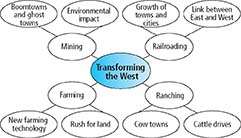CHAPTER 15: Quick Study Guide
Progress Monitoring Online
For: Self-test with vocabulary practice
Web Code: nca-1504
- The New South
Economic Growth Limits to Growth - Development of new industries such as textiles, lumber, iron, steel
- Expansion of rail lines
- Some agricultural diversification to reduce dependence on cotton
- Shortage of skilled workers
- Wealth concentrated in hands of a few
- Few banks to finance business expansion
- Key Events in the Indian Wars
Event Description Sand Creek Massacre, 1864 U.S. troops kill unarmed Cheyenne and Arapaho men, women, and children. Fetterman Massacre, 1866 Sioux lure Captain William Fetterman and his troops into an ambush. Red River War, 1874–1875 Series of conflicts ends with defeat of southern Plains Indians. Texas panhandle opened to white settlement. Battle of the Little Bighorn, 1876 Colonel George Custer meets a huge Sioux force. Custer and all 250 of his men perish. Nez Percé War, 1877 Rather than relocate to a reservation, Nez Percés flee more than 1,000 miles but are forced to surrender just short of the Canadian border. Battle of Wounded Knee, 1890 Ghost Dance raises fears of Sioux uprising. More than 100 Sioux are killed at Wounded Knee. - Transforming the West
 Quick Study Timeline
Quick Study Timeline
For: Interactive timeline
Web Code: ncp-1503






